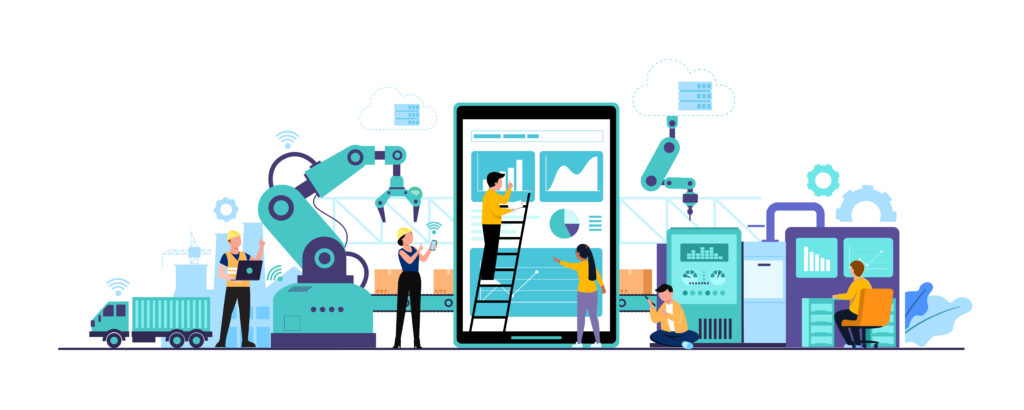The Benefits and Challenges of Implementing Hyperautomation

In today’s fast-paced business world, companies need to be agile and efficient to stay competitive. One way to achieve this is through automation. However, traditional automation tools and technologies have their limitations. This is where hyperautomation comes in. In this article, we will explore what hyperautomation is, its benefits and challenges, best practices, case studies, and tips for a successful implementation.
What is Hyperautomation?
Hyperautomation is the combination of multiple technologies such as artificial intelligence (AI), robotic process automation (RPA), machine learning (ML), and natural language processing (NLP) to automate complex business processes. It is different from traditional automation, which focuses on repetitive tasks that require simple rule-based decision-making. Hyperautomation, on the other hand, can mimic human decision-making and reasoning by analyzing data and making informed decisions.
Hyperautomation can be used to automate both front-end and back-end processes. For example, it can automate customer-facing processes such as chatbots, voice assistants, and personalized marketing campaigns. It can also automate back-end processes such as data entry, invoice processing, and supply chain management. By automating these processes, companies can reduce errors, increase efficiency, and improve customer experience.
The Benefits of Implementing Hyperautomation
The benefits of hyperautomation are vast and varied. Here are some of the most significant benefits:
Increased Efficiency
Hyperautomation can automate repetitive tasks that were previously performed manually. By doing so, it can reduce the time and effort required to complete these tasks. This frees up employees to focus on more complex and strategic tasks that require human skills such as decision-making, creativity, and problem-solving.
Improved Accuracy
Human errors are a part of any manual process. However, hyperautomation can reduce or eliminate these errors by automating the process. By doing so, it can ensure that the process is completed accurately and consistently, leading to improved quality and customer satisfaction.
Cost Savings
Hyperautomation can reduce the cost of labor by automating repetitive tasks. It can also reduce the cost of errors and rework by improving accuracy. In addition, it can reduce the cost of compliance by automating regulatory compliance processes.
Improved Customer Experience
Hyperautomation can improve the customer experience by automating customer-facing processes such as chatbots and personalized marketing campaigns. It can also improve the speed and accuracy of back-end processes such as order processing and fulfillment, leading to faster delivery times and improved customer satisfaction.
The Challenges of Implementing Hyperautomation
While the benefits of hyperautomation are significant, there are also some challenges to implementation. Here are some of the most common challenges:
Integration with Legacy Systems
Many companies have legacy systems that are not compatible with hyperautomation technologies. This can make it difficult to integrate hyperautomation into existing processes and systems. Companies may need to invest in new systems or modify existing systems to enable integration.
Skills and Expertise
Hyperautomation requires a combination of technical and business skills. Companies may not have the necessary skills and expertise in-house to implement hyperautomation. They may need to hire new employees, train existing employees, or partner with external vendors to implement hyperautomation.
Data Quality
Hyperautomation relies on high-quality data to make informed decisions. However, many companies have data quality issues such as incomplete, inaccurate, or inconsistent data. Companies may need to invest in data quality initiatives to ensure that their data is suitable for hyperautomation.
Regulatory Compliance
Hyperautomation can automate regulatory compliance processes, but companies need to ensure that the automation is compliant with regulations. Companies may need to invest in regulatory compliance expertise to ensure that their hyperautomation processes are compliant.
Hyperautomation Tools and Technologies
Hyperautomation requires a combination of technologies such as AI, RPA, ML, and NLP. Here are some of the most popular hyperautomation tools and technologies:
Robotic Process Automation (RPA)
RPA is a technology that automates repetitive tasks such as data entry and invoice processing. It can mimic human actions such as clicking buttons and entering data into fields.
Artificial Intelligence (AI)
AI is a technology that can simulate human intelligence such as decision-making and reasoning. It can be used to automate complex processes that require human skills.
Machine Learning (ML)
ML is a subset of AI that can learn from data and improve over time. It can be used to automate processes that require decision-making based on data.
Natural Language Processing (NLP)
NLP is a technology that can understand human language and respond appropriately. It can be used to automate customer-facing processes such as chatbots and voice assistants.
Hyperautomation Best Practices
Here are some best practices for implementing hyperautomation:
Start Small
Hyperautomation is a complex process that requires careful planning and execution. Companies should start small by automating a few processes and gradually scale up as they gain experience.
Involve Stakeholders
Hyperautomation can impact multiple departments and stakeholders within a company. Companies should involve all stakeholders in the planning and implementation process to ensure that everyone is on board and understands the benefits and challenges.
Invest in Training
Hyperautomation requires a combination of technical and business skills. Companies should invest in training their employees to ensure that they have the necessary skills and expertise to implement and maintain hyperautomation.
Monitor and Measure
Hyperautomation can generate vast amounts of data. Companies should monitor and measure the performance of their hyperautomation processes to ensure that they are meeting their goals and objectives.
Case Studies of Successful Hyperautomation Implementations
Here are some examples of successful hyperautomation implementations:
Coca-Cola
Coca-Cola implemented hyperautomation to streamline its order processing and fulfillment process. By automating this process, Coca-Cola reduced order processing time by 30% and increased order accuracy by 95%.
Siemens
Siemens implemented hyperautomation to automate its supply chain management process. By doing so, Siemens reduced order processing time by 40% and increased order accuracy by 98%.
Unilever
Unilever implemented hyperautomation to automate its invoice processing process. By automating this process, Unilever reduced invoice processing time by 70% and increased invoice accuracy by 99%.
Tips for a Successful Hyperautomation Implementation
Here are some tips for a successful hyperautomation implementation:
Define Goals and Objectives
Companies should define their goals and objectives for hyperautomation before implementing it. This will help them measure the success of their hyperautomation processes.
Choose the Right Processes
Companies should choose processes that are suitable for hyperautomation. They should prioritize processes that are repetitive, rules-based, and require minimal human intervention.
Involve IT and Business Units
Hyperautomation requires a combination of technical and business skills. Companies should involve both IT and business units in the planning and implementation process to ensure that everyone is on board and understands the benefits and challenges.
Monitor and Measure
Companies should monitor and measure the performance of their hyperautomation processes to ensure that they are meeting their goals and objectives. They should also be prepared to make changes and adjustments based on the data generated by their hyperautomation processes.
Hyperautomation vs Automation: What’s the Difference?
Hyperautomation is often confused with automation. While both involve the use of technology to automate processes, there are some differences between the two. Automation is typically focused on repetitive tasks that require simple rule-based decision-making. Hyperautomation, on the other hand, can automate complex processes that require human skills such as decision-making and reasoning.
The Future of Hyperautomation
Hyperautomation is still a relatively new technology, but it is rapidly gaining popularity. According to Gartner, hyperautomation will be one of the top technology trends in 2021. As hyperautomation continues to evolve, it will become more accessible and easier to implement. This will lead to increased adoption and greater benefits for companies that implement it.
Conclusion
Hyperautomation is a powerful technology that can revolutionize the way companies operate. It can improve efficiency, accuracy, cost savings, and customer experience. However, hyperautomation also has its challenges, such as integration with legacy systems, skills and expertise, data quality, and regulatory compliance. By following best practices, learning from case studies, and implementing tips for a successful implementation, companies can overcome these challenges and reap the benefits of hyperautomation.
